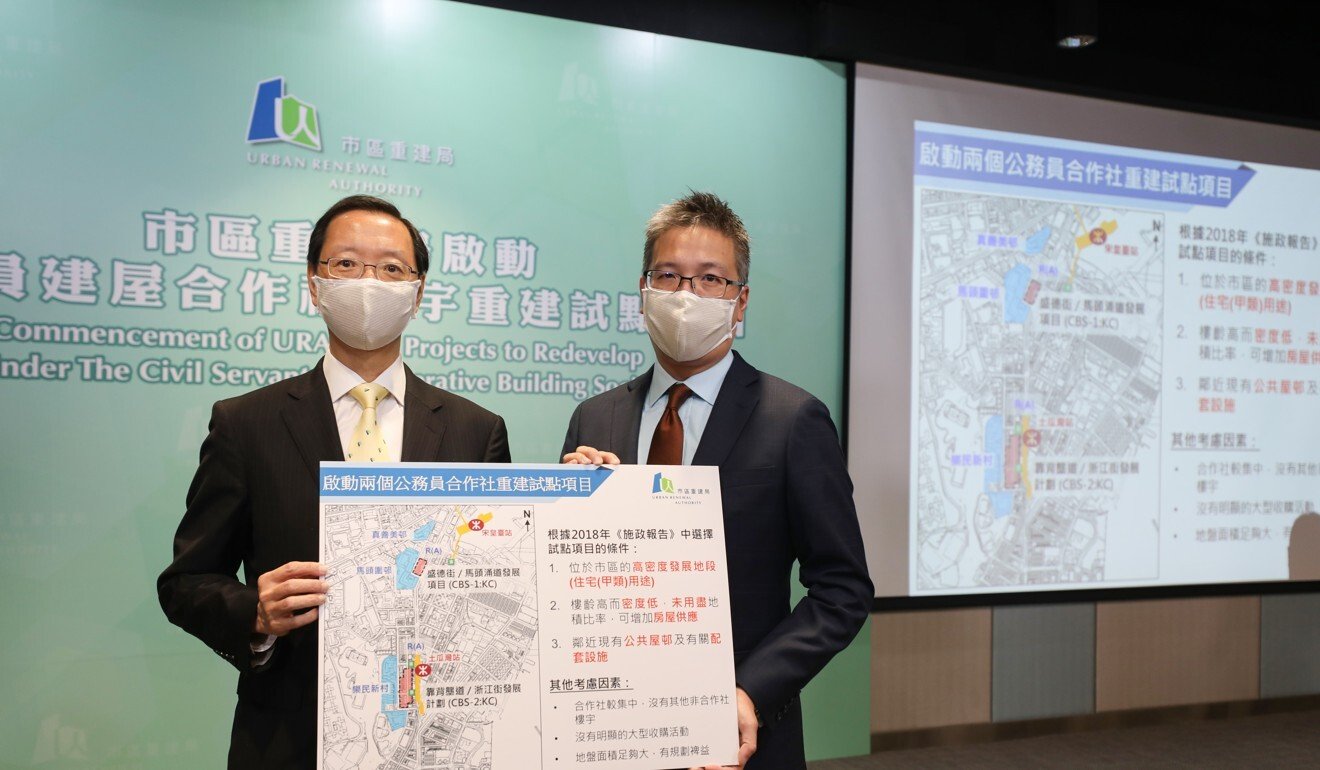
Hong Kong’s Urban Renewal Authority to build more than 3,000 flats at redeveloped Kowloon City site
- The redevelopment, first proposed in 2018, will increase the number of units available at the site more than fivefold and include some public housing
- But first they must negotiate with existing residents, entailing an expected HK$10 billion in acquisition costs
Hong Kong’s Urban Renewal Authority (URA) on Friday took the wraps off its biggest-ever project, a plan they say will turn housing blocks once allocated for civil servants into more than 3,000 residential flats, a fivefold increase from the site’s current number.
The two pilot projects in Kowloon City, first proposed by Chief Executive Carrie Lam Cheng Yuet-ngor in 2018, are expected to entail more than HK$10 billion (US$1.29 billion) in acquisition costs as the authority goes about the process of negotiating with existing residents.
URA director of planning and design Wilfred Au Chun-ho said the site was chosen due to the age of the housing blocks as well as their low density, which has not fully maximised the available space.

Other advantages included the buildings’ location near existing public housing estates, lack of competing acquisition actions by private developers, and relatively large size.
“The redevelopment will generate about five times the number of existing flats, from about 600 to 3,000, boosting housing supply,” Au said.
That number will easily outdistance the ongoing Kwun Tong town centre redevelopment, which will produce about 2,300 units.
The two Kowloon City sites, which currently host an estimated 610 households, are located on Shing Tak Street and Ma Tau Chung Road, as well as Kau Pui Lung Road and Chi Kiang Street. The first has a total area of about 5,160 square meters and is expected to yield about 640 residential flats by 2029.
Urban Renewal Authority, which tackles housing decay, sees dramatic fall in surplus
The second, much larger site – near the future To Kwa Wan MTR station – boasts an area of about 16,470 square meters, and will encompass 2,500 flats by 2030-2031. An unknown number of units, to occupy about a third of the area, will be reserved for public housing.
Au said the area’s revamp will also create a “better pedestrian environment and more liveable community” through replanning and landscaping. Wider pavements, an underground shopping street connected to the future MTR station and an underground car park providing some 400 parking spaces will be among the improvements.
The existing flats were built under the Civil Servants’ Co-operative Building Society Scheme, which was in operation between 1952 and the mid-1980s. The government granted land to those who formed co-operatives – usually at a third of market value – to build their homes.

The owners, however, cannot sell their properties unless at least 75 per cent of members agree to dissolve the society. An owner wishing to sell also needs to pay the government a land premium – defined as the difference in the value of the property before and after redevelopment.
Currently, many of the flats are run down and vacant. Most do not have lifts and some are occupied by ageing retired civil servants. But redevelopment plans with private developers in the past have stalled due to disagreements over the land premium.
Of the 238 civil servants’ co-operative building societies in Hong Kong, 191 have been dissolved but only 12 have been redeveloped.
The URA will facilitate the legal process of dissolving the cooperative societies and the property acquisition by providing free legal consultation services to the flat owners.
Urban Renewal Authority to focus on bigger Hong Kong homes in next project
Affected owners living at the site will have the option of purchasing subsidised flats via the Hong Kong Housing Society or other flats provided by the URA.
Lawmaker Tony Tse Wai-chuen, who represents the architectural, surveying, planning and landscape sector, said the plan was long overdue, as the old civil servants’ homes represented a huge reservoir of housing resources the city could tap into.
“It should not take nine to 10 years to complete the reconstruction. The URA should speed up the process to relieve Hong Kong’s housing crunch,” he said.
Leung Tak-yee, a retired civil servant affected by the development, said she welcomed the plan as her property that was built in the 1960s suffered from many structural problems, including roof that leaked when it rained.
The 72-year-old, who bought the flat in 1992 and lives there with three family members, demanded more clarity from the government.
“I want to know how much I need to pay back to the government in terms of land premium, because my compensation may be worth a lot less and not enough for me to buy other homes,” she said.
Help us understand what you are interested in so that we can improve SCMP and provide a better experience for you. We would like to invite you to take this five-minute survey on how you engage with SCMP and the news.
